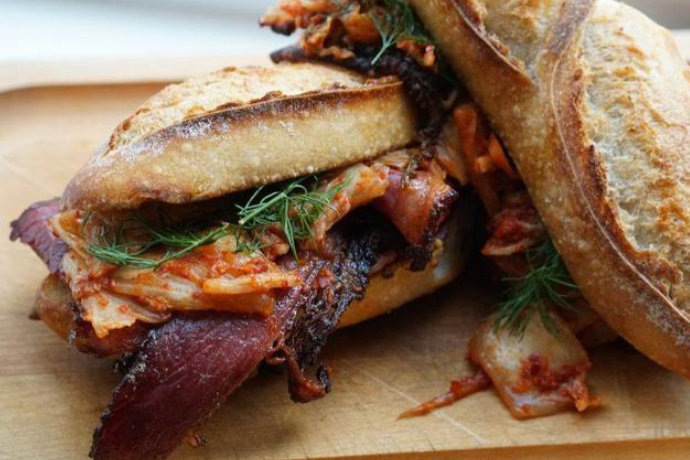Speaking to a room packed with restaurant industry professionals at the National Restaurant Association Restaurant, Hotel-Motel Show in Chicago on May 19, Nancy Kruse, president, The Kruse Co., Atlanta, said, “You never met a trend that you couldn’t put on top of a hamburger.”
She cited Red Robin’s ramen burger, which is a beef patty served on a crispy seasoned ramen bun topped with teriyaki and Chiu Chow aioli, a medley of chili-infused shredded cabbage, carrot and onion and garnished with fresh basil.
Plan Check Kitchen + Bar, with multiple locations in the Los Angeles area, offers a namesake burger featuring Americanized dashi cheese, ketchup leather, schmaltz onions and mixed pickles on a crunch bun. Ketchup leather is a house specialty. Ketchup is spread onto a baking sheet and dehydrated in the oven at a low temperature for three hours. It’s then sliced into a square.
The East Coast chain Dogfish Head Alehouse is known for its burger-of-the-week program. On-trend specialties have included the Caprese, which is a patty topped with spring mix, fresh mozzarella, Roma tomatoes and a balsamic glaze. The General Tso is a half-pound patty topped with a blend of carrots, red onion, and red and green peppers all tossed in General Tso sauce.
Consumers are often more willing to taste unfamiliar ingredients when they are delivered by a familiar food, such as a burger or even fried chicken, according to Kruse. A quick way for culinary professionals to participate in the latest trend is to offer limited-time products, which allows for experimenting with trending ingredients. This is something that packaged meat and poultry processors can do, too, with creative use of seasonings, marinades and meal kits.
Trending ingredients are not just for burgers. Steingold’s of Chicago, a modern twist on the authentic Jewish deli, serves the Sister-in-Law sandwich. It’s pastrami with dill kimchi and anchovy mustard on a baguette.

Among its extensive fresh Atlantic seafood menu, Eventide, Portland, Maine, offers Japanese fried chicken. It features gomashio, a dry condiment made from unhulled sesame seeds.
New York City’s Gramercy Tavern offers duck meatballs with the trending chile crisp. This is a chili oil-based condiment packed with chilies, Sichuan peppercorns, spices, roasted soy nuts, fried onion and fried garlic.
The fried chicken sandwich at Empellon Al Pastor, New York City, features toum, a Lebanese condiment made with garlic, lemon juice, olive oil and salt.
“Toum is coming on strong,” said Ms. Kruse, noting its simplicity and versatility.
Other trending condiments with application on meat and poultry, according to Kruse, include, Zhoug, a blend of hot pepper, garlic and cilantro, and za’atar, a combination of green herbs, sesame and olive oil. These all compliment the Mediterranean movement that is gaining traction in all food and beverage.
Kruse said kebobs are a win-win for processors, operators, delivery services and consumers.
“They hold up well. They allow for portion control of the protein, which in turn assists with managing costs,” she said.
She cited Zov’s, a multi-location Mediterranean restaurant in the Los Angeles area that offers an array of kebobs and other seasoned meat dishes, such as tahini chicken tacos and a spiced lamb burger.

